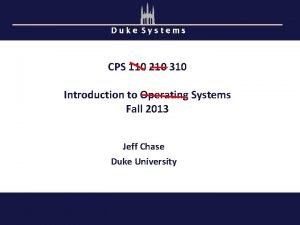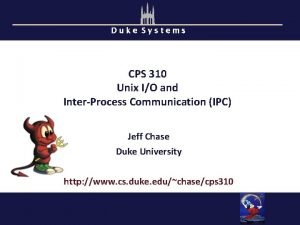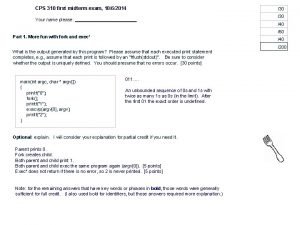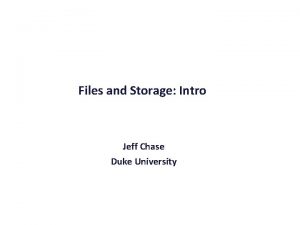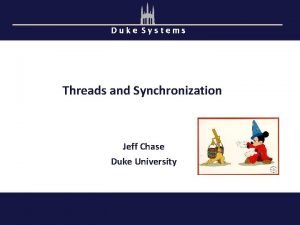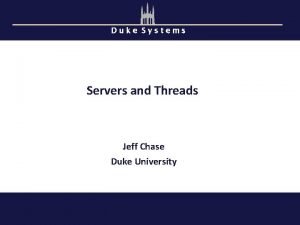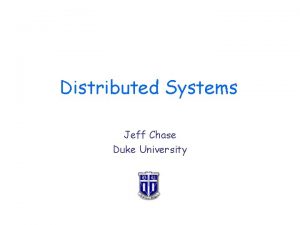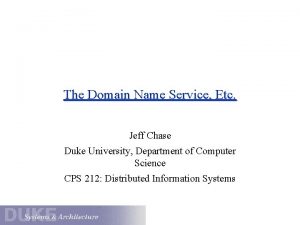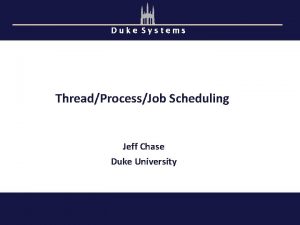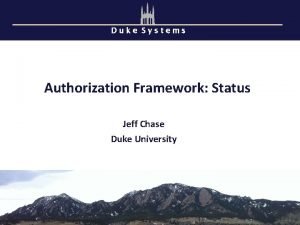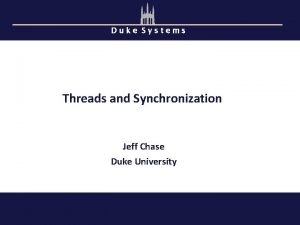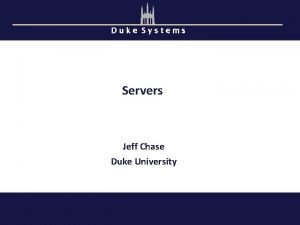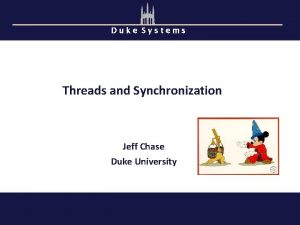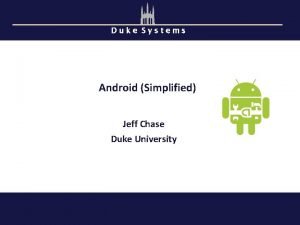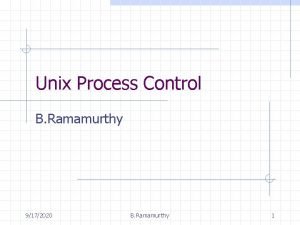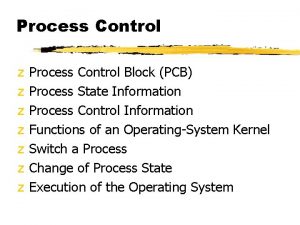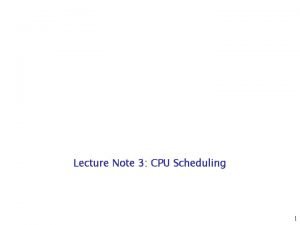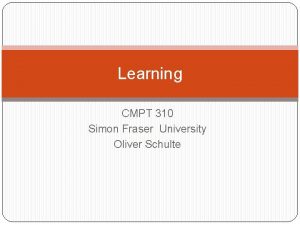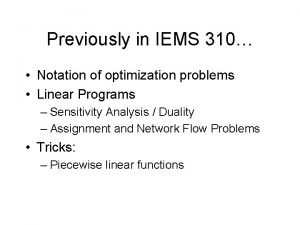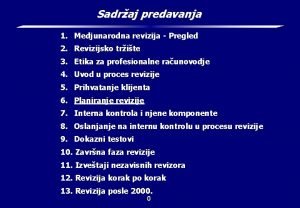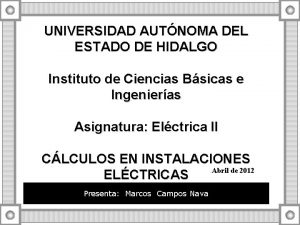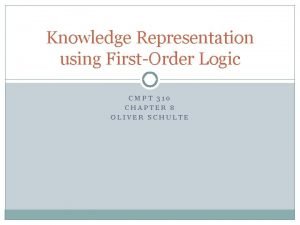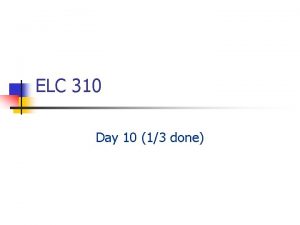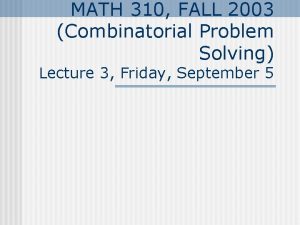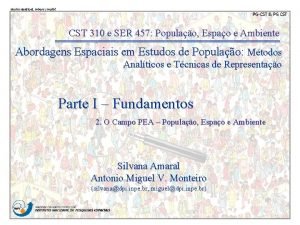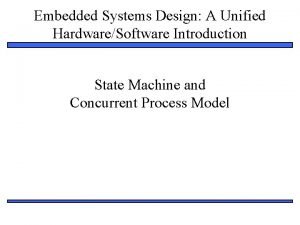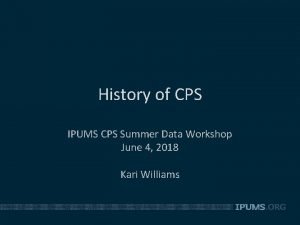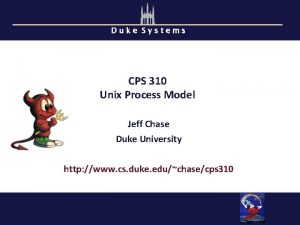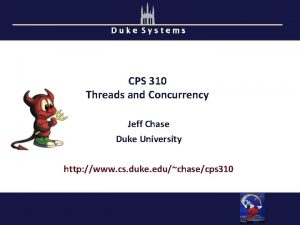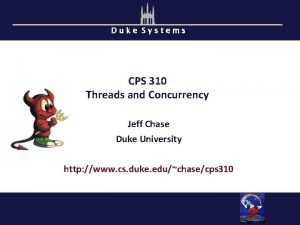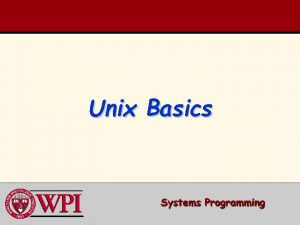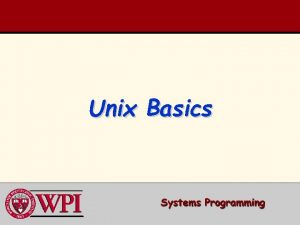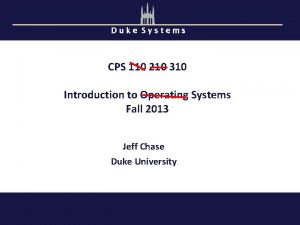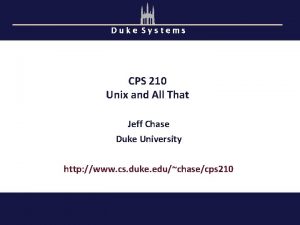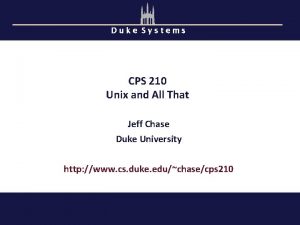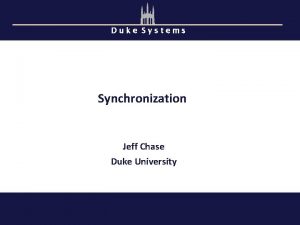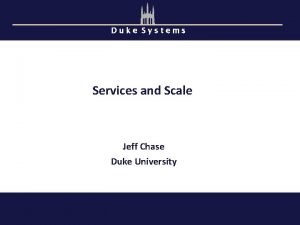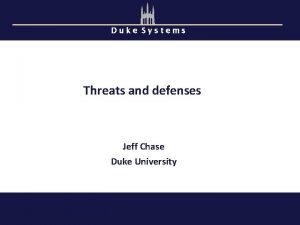Duke Systems CPS 310 Unix Process Model Jeff





















![Example: Chrome browser [Google Chrome Comics] Example: Chrome browser [Google Chrome Comics]](https://slidetodoc.com/presentation_image_h/113fed3f0fc159384cc6b7ea0db6f00a/image-22.jpg)

![Problem: heap memory and fragmentation [Google Chrome Comics] Problem: heap memory and fragmentation [Google Chrome Comics]](https://slidetodoc.com/presentation_image_h/113fed3f0fc159384cc6b7ea0db6f00a/image-24.jpg)

![Processes for fault isolation [Google Chrome Comics] Processes for fault isolation [Google Chrome Comics]](https://slidetodoc.com/presentation_image_h/113fed3f0fc159384cc6b7ea0db6f00a/image-26.jpg)
![[Google Chrome Comics] [Google Chrome Comics]](https://slidetodoc.com/presentation_image_h/113fed3f0fc159384cc6b7ea0db6f00a/image-27.jpg)


![Unix fork/exec/exit/wait syscalls fork child fork parent program initializes child context exec*(“program” [argvp, envp]); Unix fork/exec/exit/wait syscalls fork child fork parent program initializes child context exec*(“program” [argvp, envp]);](https://slidetodoc.com/presentation_image_h/113fed3f0fc159384cc6b7ea0db6f00a/image-30.jpg)



![A simple program: forkexec … main(int argc, char *argv[]) { Always check return int A simple program: forkexec … main(int argc, char *argv[]) { Always check return int](https://slidetodoc.com/presentation_image_h/113fed3f0fc159384cc6b7ea0db6f00a/image-34.jpg)



![What does this code do? int main(int argc, char *argv[]) { printf("about to run What does this code do? int main(int argc, char *argv[]) { printf("about to run](https://slidetodoc.com/presentation_image_h/113fed3f0fc159384cc6b7ea0db6f00a/image-38.jpg)




![Simple I/O: args and printf #include <stdio. h> int main(int argc, char* argv[]) { Simple I/O: args and printf #include <stdio. h> int main(int argc, char* argv[]) {](https://slidetodoc.com/presentation_image_h/113fed3f0fc159384cc6b7ea0db6f00a/image-43.jpg)
![Environment variables (rough) #include <stdio. h> #include <stdlib. h> int main(int argc, char* argv[], Environment variables (rough) #include <stdio. h> #include <stdlib. h> int main(int argc, char* argv[],](https://slidetodoc.com/presentation_image_h/113fed3f0fc159384cc6b7ea0db6f00a/image-44.jpg)

![Environment variables (safer) #include <stdio. h> #include <stdlib. h> int main(int argc, char* argv[], Environment variables (safer) #include <stdio. h> #include <stdlib. h> int main(int argc, char* argv[],](https://slidetodoc.com/presentation_image_h/113fed3f0fc159384cc6b7ea0db6f00a/image-46.jpg)


![forkexec revisited again … main(int argc, char *argv[], char *envp[]) { int status; int forkexec revisited again … main(int argc, char *argv[], char *envp[]) { int status; int](https://slidetodoc.com/presentation_image_h/113fed3f0fc159384cc6b7ea0db6f00a/image-49.jpg)



- Slides: 52

Duke Systems CPS 310 Unix Process Model Jeff Chase Duke University http: //www. cs. duke. edu/~chase/cps 310

Operating Systems: The Classical View Programs run as independent processes. data Protected system calls Protected OS kernel mediates access to shared resources. Each process has a private virtual address space and one or more threads. . and upcalls (e. g. , signals) Threads enter the kernel for OS services. The kernel code and data are protected from untrusted processes.

Today • We understand threads and concurrency now. • Add a kernel and address spaces “vanilla Unix” • Flesh out Unix process model and syscall API • Kernel interactions • Using the process model • Imagine: – Your thread library is “really” a kernel. – Each thread is a classical process. – i. e. , Each thread has its own VAS. – i. e. , Threads/processes share data only within/via the kernel.

Thread states and transitions We will presume that these transitions occur only in kernel mode. This is true in classical Unix and in systems with pure kernel-based threads. Before a thread can sleep, it must first enter the kernel via trap (syscall) or fault. Before a thread can yield, it must enter the kernel, or the core must take an interrupt to return control to the kernel. running sleep blocked STOP wait wakeup yield preempt dispatch ready On entry to the running state, kernel code decides if/when/how to enter user mode, and sets up a suitable context E. g. , for initial start, return from fault or syscall, or to deliver a signal.

Kernel Stacks and Trap/Fault Handling Threads execute user code on a user stack in user space (the process virtual address space). Each thread has a second kernel stack in kernel space (VM accessible only in kernel mode). data stack syscall dispatch table stack System calls and faults run in kernel mode on a kernel stack for the current thread. Kernel code running in P’s process context has access to P’s virtual memory. The syscall (trap) handler makes an indirect call through the system call dispatch table to the handler registered for the specific system call.

Upcall example: Unix signals • Signals are asynchronous notifications to a process that some event of interest to it has occurred. • A process may register signal handlers for various events relating to the process. The signal handlers are procedures in user space. • To deliver a signal, the kernel redirects a user thread to execute a selected registered signal handler in user mode. • Unix signals take a default action if no handler is registered. – E. g. , segmentation fault die. Other actions: ignore, stop data Protected system calls data . . . and upcalls (e. g. , signals)

The kernel must be bulletproof Secure kernels handle system calls verrry carefully. Syscalls indirect through syscall dispatch table by syscall number. No direct calls to kernel routines from user space! What about references to kernel data objects passed as syscall arguments (e. g. , file to read or write)? User program / user space user buffers trap copyout copyin read() {…} write() {…} kernel Kernel copies all arguments into kernel space and validates them. Kernel interprets pointer arguments in context of the user VAS, and copies the data in/out of kernel space (e. g. , for read and write syscalls). Use an integer index into a kernel table that points at the data object. The value is called a handle or descriptor. No direct pointers to kernel data from user space!

Unix: A lasting achievement? “Perhaps the most important achievement of Unix is to demonstrate that a powerful operating system for interactive use need not be expensive…it can run on hardware costing as little as $40, 000. ” DEC PDP-11/24 The UNIX Time-Sharing System* D. M. Ritchie and K. Thompson 1974 http: //histoire. info. online. fr/pdp 11. html

Process management • OS offers system call APIs for managing processes. – Create processes (children) – Control processes – Monitor process execution – “Join”: wait for a process to exit and return a result – “Kill”: send a signal to a process – Establish interprocess communication (IPC: later) – Launch a program within a process • We study the Unix process abstraction as an example. – Illustrative and widely used for 40+ years! – Optional: Use it to build your own shell.

Example: Unix fork The Unix fork() system call creates/launches a new thread, in its own fresh virtual address space: it creates a new process. (Thread + VAS == Process. ) Strangely, the new (“child”) process is an exact clone of the calling (“parent”) process. fork Oh Ghost of Walt, please don’t sue me.

Unix fork/exit syscalls int pid = fork(); Create a new process that is a clone of its parent. Return child process ID (pid) to parent, return 0 to child. parent fork parent child time exit(status); Exit with status, destroying the process. Status is returned to the parent. Note: this is not the only way for a process to exit! data exit data p pid: 5587 pid: 5588

fork The fork syscall returns twice: int pid; int status = 0; if (pid = fork()) { /* parent */ …. . } else { /* child */ …. . exit(status); } It returns a zero in the context of the new child process. It returns the new child process ID (pid) in the context of the parent.

A simple program: sixforks … int main(int argc, char* argv) { fork(); fork(); printf("Process %d exiting. n", getpid()); } getpid syscall: Get process. ID of current process. How many processes are created by these six forks? chase$ cc –o sixforks. c chase$. /sixforks ? ? ? chase$

A simple program: sixforks … int main(int argc, char* argv) { fork(); fork(); printf("Process %d exiting. n", getpid()); } chase$ cc –o sixforks. c chase$. /sixforks Process 15191 exiting. Process 15200 exiting. Process 15195 exiting. Process 15194 exiting. Process 15197 exiting. Process 15202 exiting. Process 15193 exiting. Process 15198 exiting. Process 15215 exiting. Process 15217 exiting. Process 15218 exiting. Process 15203 exiting. Chase$ Process 15212 exiting. Process 15196 exiting. Process 15222 exiting. Process 15213 exiting. Process 15221 exiting. Process 15224 exiting. Process 15206 exiting. Process 15216 exiting. Process 15205 exiting. Process 15207 exiting. Process 15201 exiting. Process 15214 exiting. Process 15225 exiting. Process 15199 exiting. Process 15226 exiting. Process 15208 exiting. Process 15229 exiting. Process 15220 exiting. Process 15209 exiting. Process 15232 exiting. Process 15219 exiting. Process 15233 exiting. Process 15223 exiting. Process 15210 exiting. Process 15234 exiting. Process 15228 exiting. Process 15192 exiting. Process 15230 exiting. Process 15211 exiting. Process 15227 exiting. Process 15239 exiting. Process 15231 exiting. Process 15242 exiting. Process 15243 exiting. Process 15240 exiting. Process 15236 exiting. Process 15241 exiting. Process 15244 exiting. Process 15247 exiting. Process 15235 exiting. Process 15245 exiting. Process 15250 exiting. Process 15248 exiting. Process 15249 exiting. Process 15204 exiting. Process 15238 exiting. Process 15251 exiting. Process 15237 exiting. Process 15252 exiting. Process 15253 exiting. Process 15246 exiting. Process 15254 exiting.

sixforks: some questions • What if I want to create six children, but I don’t want my children to have children of their own? • What if I want the program to print the total number of processes created? How? (Other than by having the program do the math. ) • How much memory does this program use? How many pages? • How does this test system assign process IDs? • Why do the process IDs print out of order?

fork (original concept)

fork in action today void dofork() { int cpid = fork(); if (cpid < 0) { perror("fork failed: "); exit(1); } else if (cpid == 0) { child(); } else { parent(cpid); } } Fork is conceptually difficult but syntactically clean and simple. I don’t have to say anything about what the new child process “looks like”: it is an exact clone of the parent! The child has a new thread executing at the same point in the same program. The child is a new instance of the running program: it has a “copy” of the entire address space. The “only” change is the process ID and return value cpid! The parent thread continues on its way. The child thread continues on its way.

wait syscall int pid; int status = 0; if (pid = fork()) { /* parent */ …. . pid = wait(&status); } else { /* child */ …. . exit(status); } Parent uses wait to sleep until the child exits; wait returns child pid and status. Wait variants allow wait on a specific child, or notification of stops and other signals. Recommended: use waitpid(). Warning: the uses of the terms wait and signal should not be confused with the monitor/CV primitives of the same names.

wait Process states (i. e. , states of the main thread of the process) “wakeup” “sleep” Note: in modern Unix systems the wait syscall has many variants and options.

A simple program: forkdeep int count = 0; int level = 0; void child() { level++; output pids if (level < count) dofork(); if (level == count) sleep(3); /* pause 3 secs */ } void parent(int childpid) { output pids wait for child to finish } main(int argc, char *argv[]) { count = atoi(argv[1]); dofork(); We’ll see later where output pid arguments come from. } level==1 level==2

chase$. /forkdeep 4 30866 -> 30867 -> 30868 30868 -> 30869 30869 -> 30870 30869 30868 30867 30866 chase$. /forkdeep 3 11496 -> 11498 -> 11499 11499 -> 11500 11499 11498 11496 chase$
![Example Chrome browser Google Chrome Comics Example: Chrome browser [Google Chrome Comics]](https://slidetodoc.com/presentation_image_h/113fed3f0fc159384cc6b7ea0db6f00a/image-22.jpg)
Example: Chrome browser [Google Chrome Comics]

Processes in the browser Chrome makes an interesting choice here. But why use processes? [Google Chrome Comics]
![Problem heap memory and fragmentation Google Chrome Comics Problem: heap memory and fragmentation [Google Chrome Comics]](https://slidetodoc.com/presentation_image_h/113fed3f0fc159384cc6b7ea0db6f00a/image-24.jpg)
Problem: heap memory and fragmentation [Google Chrome Comics]

Solution: whack the whole process When a process exits, all of its virtual memory is reclaimed as one big slab. [Google Chrome Comics]
![Processes for fault isolation Google Chrome Comics Processes for fault isolation [Google Chrome Comics]](https://slidetodoc.com/presentation_image_h/113fed3f0fc159384cc6b7ea0db6f00a/image-26.jpg)
Processes for fault isolation [Google Chrome Comics]
![Google Chrome Comics [Google Chrome Comics]](https://slidetodoc.com/presentation_image_h/113fed3f0fc159384cc6b7ea0db6f00a/image-27.jpg)
[Google Chrome Comics]

Processes: A Closer Look virtual address space + The address space is a private name space for a set of memory segments used by the process. The kernel must initialize the process virtual memory for the program to run. thread(s) stack process control block (PCB) + Each process has at least one thread (the “main thread”) bound to the VAS. Each thread has a stack addressable in the VAS. The kernel can suspend/restart a thread wherever and whenever it wants. user ID process ID parent PID sibling links children current directory resources The OS maintains some kernel state for each process in the kernel’s internal data structures: e. g. , a file descriptor table, links to maintain the process tree, current directory, and a place to store the exit status.

Process, kernel, and syscalls process user space syscall stub user buffers read() {…} syscall dispatch table I/O descriptor table trap copyout copyin read() {…} write() {…} kernel I/O objects Return to user mode
![Unix forkexecexitwait syscalls fork child fork parent program initializes child context execprogram argvp envp Unix fork/exec/exit/wait syscalls fork child fork parent program initializes child context exec*(“program” [argvp, envp]);](https://slidetodoc.com/presentation_image_h/113fed3f0fc159384cc6b7ea0db6f00a/image-30.jpg)
Unix fork/exec/exit/wait syscalls fork child fork parent program initializes child context exec*(“program” [argvp, envp]); Overlay the calling process with a new program, and transfer control to it, passing arguments and environment. exit(status); Exit with status, destroying the process. time wait int pid = fork(); Create a new process that is a clone of its parent, running the same program. exit int pid = wait*(&status); Wait for exit (or other status change) of a child, and “reap” its exit status. Recommended: use waitpid().

But how do I run a new program in my child process? • The child, or any process really, can replace its program in midstream. • exec* system call: “forget everything in my address space and reinitialize my entire address space with stuff from a named program file. ” • The exec system call never returns: the new program executes in the calling process until it dies (exits). – The code from the parent program runs in the child process and controls its future. The parent program selects the child program that the child process will run (via exec) – But don’t forget to check error status from exec*! It returns an error to parent program if it fails.

Running a program sections code (“text”) constants initialized data Process segments data Program Unix: fork/exec Thread virtual memory When a program launches, the OS creates a process to run it, with a main thread to execute the code, and a virtual memory to store the running program’s code and data.

exec (original concept)
![A simple program forkexec mainint argc char argv Always check return int A simple program: forkexec … main(int argc, char *argv[]) { Always check return int](https://slidetodoc.com/presentation_image_h/113fed3f0fc159384cc6b7ea0db6f00a/image-34.jpg)
A simple program: forkexec … main(int argc, char *argv[]) { Always check return int status; from syscalls and show int rc = fork(); any errors! if (rc < 0) { perror("fork failed: "); exit(1); } else if (rc == 0) { printf("I am a child: %d. n", getpid()); Parent program argv++; running in child process execve(argv[0], argv, 0); /* NOTREACHED */ A successful exec* never } else { returns to calling program. waitpid(rc, &status, 0); printf(“Child %d exited with status %dn. ", rc, WEXITSTATUS(status)); Reap exit status return value } from child via exit/wait. }

A simple program: prog 0 … exit syscall: int Pass exit status return main() value to parent via exit/wait. { printf("Hi from %d!n", getpid()); exit(72); chase$ cc –o forkexec. c } chase$ cc –o prog 0. c getpid syscall: Get process. ID of current process. chase$. /forkexec prog 0 I am a child: 11384. Hi from 11384! Child 11384 exited with status 72. chase$

Kernel/user transitions fork/exec/exit The kernel may start and kill threads, and/or arbitrarily change the user virtual memory and/or thread context. fork It does it all the time. exec wait parent child fork syscall return wait* call wait* return time fork exit exec* entry to syscall user mode in main EXIT

About the previous slide • A trap is a system call, e. g. , fork/exec/exit/wait/ or open/close/read/write or pipe/dup 2. • A program is an executable file that may be launched in a process, e. g. , with an exec* system call. When a program is running in a process that program controls the process. More precisely, the program controls the behavior of a thread in the process while that thread is running in user mode. • When I say that "a program invokes a system call" or "a process does a trap" I mean that a thread is running in a user program in a process, and that thread executes a trap instruction in the program, for the purpose of entering the kernel to perform a system call. In the example: • Exec* system call is invoked by the parent program running in the child process. • Exec* system call "returns" into the program whose name was the first argument to exec*. That is the program I call the "child program": it is now running in the child process, having replaced the parent program in the child process. After exec*, the child program begins executing in its main(). (Be sure you understand how that happened. )
![What does this code do int mainint argc char argv printfabout to run What does this code do? int main(int argc, char *argv[]) { printf("about to run](https://slidetodoc.com/presentation_image_h/113fed3f0fc159384cc6b7ea0db6f00a/image-38.jpg)
What does this code do? int main(int argc, char *argv[]) { printf("about to run program %s. n", argv[0]); execve(argv[0], argv, 0); perror("exec failed"); }

Exec setup (ABI) The details aren’t important. The point is: The exec system call sets up the VAS of the calling process to execute a named program. Exec passes two arrays of strings to the new program’s main(): an array of arguments and an array of named environment variables. It stages the argv/env arrays in the VAS before returning to user mode to start execution at main(). System V Application Binary Interface AMD 64 Architecture Processor Supplement

But how is the first process made?

Init and Descendants Kernel “handcrafts” initial process to run “init” program. Other processes descend from init, including one instance of the login program for each terminal. Login runs user shell in a child process after user authenticates. User shell runs user commands as child processes.

Environment variables and property lists • The environment variable array is a property list. – The property list construct is very common and useful! – Also commonly used for configuration files. – It goes by various names: Java plist, Windows Registry, INI files • Each element of the list is a string: “NAME=VALUE”. • The standard library has primitives to look up the VALUE corresponding to a NAME. • In Unix systems: standard environment variables are handed down through the shell: they give programs lots of information about the environment. • The parent specifies them to the exec* syscall.
![Simple IO args and printf include stdio h int mainint argc char argv Simple I/O: args and printf #include <stdio. h> int main(int argc, char* argv[]) {](https://slidetodoc.com/presentation_image_h/113fed3f0fc159384cc6b7ea0db6f00a/image-43.jpg)
Simple I/O: args and printf #include <stdio. h> int main(int argc, char* argv[]) { int i; printf("arguments: %dn", argc); for (i=0; i<argc; i++) { printf("%d: %sn", i, argv[i]); } } chase$ cc –o prog 1. c chase$. /forkexec prog 1 arguments: 1 0: prog 1 child 19178 exited with status 0 chase$. /forkexec prog 1 one 2 3 arguments: 4 0: prog 1 1: one 2: 2 3: 3 Child 19181 exited with status 0.
![Environment variables rough include stdio h include stdlib h int mainint argc char argv Environment variables (rough) #include <stdio. h> #include <stdlib. h> int main(int argc, char* argv[],](https://slidetodoc.com/presentation_image_h/113fed3f0fc159384cc6b7ea0db6f00a/image-44.jpg)
Environment variables (rough) #include <stdio. h> #include <stdlib. h> int main(int argc, char* argv[], char* envp[]) { int i; int count = atoi(argv[1]); for (i=0; i < count; i++) { printf("env %d: %sn", i, envp[i]); } }

Environment variables (rough) chase$ cc –o env 0. c chase$. /env 0 Segmentation fault: 11 chase$. /env 0 12 env 0: TERM_PROGRAM=Apple_Terminal env 1: TERM=xterm-256 color env 2: SHELL=/bin/bash env 3: TMPDIR=/var/folders/td/ng 76 cpqn 4 zl 1 wrs 57 hldf 1 vm 0000 gn/T/ env 4: Apple_Pub. Sub_Socket_Render=/tmp/launch-Ot. U 5 Bb/Render env 5: TERM_PROGRAM_VERSION=309 env 6: OLDPWD=/Users/chase/c 210 -stuff env 7: TERM_SESSION_ID=FFCE 3 A 14 -1 D 4 B-4 B 08… env 8: USER=chase env 9: COMMAND_MODE=unix 2003 env 10: SSH_AUTH_SOCK=/tmp/launch-W 03 wn 2/Listeners env 11: __CF_USER_TEXT_ENCODING=0 x 1 F 5: 0: 0 chase$
![Environment variables safer include stdio h include stdlib h int mainint argc char argv Environment variables (safer) #include <stdio. h> #include <stdlib. h> int main(int argc, char* argv[],](https://slidetodoc.com/presentation_image_h/113fed3f0fc159384cc6b7ea0db6f00a/image-46.jpg)
Environment variables (safer) #include <stdio. h> #include <stdlib. h> int main(int argc, char* argv[], char* envp[]) { int i; int count; if (argc < 2) { fprintf(stderr, "Usage: %s <count>n", argv[0]); exit(1); } count = atoi(argv[1]); for (i=0; i < count; i++) { if (envp == 0) { printf("env %d: nothing!n", i); exit(1); } else if (envp[i] == 0) { printf("env %d: null!n", i); exit(1); } else printf("env %d: %sn", i, envp[i]); } }

Where do environment variables come from? chase$ cc –o env. c chase$. /env chase$. /forkexec env Usage: env <count> child 19195 exited with status 1 chase$. /forkexec env 1 env 0: null! child 19263 exited with status 1 chase$

forkexec revisited char *lala = "lalalan"; char *nothing = 0; … main(int argc, char *argv[]) { int status; int rc = fork(); if (rc < 0) { … } else if (rc == 0) { argv++; execve(argv[0], argv, &lala); } else { … } chase$ cc –o fel forkexec-lala. c chase$. /fel env 1 env 0: lalala child 19276 exited with status 0 chase$
![forkexec revisited again mainint argc char argv char envp int status int forkexec revisited again … main(int argc, char *argv[], char *envp[]) { int status; int](https://slidetodoc.com/presentation_image_h/113fed3f0fc159384cc6b7ea0db6f00a/image-49.jpg)
forkexec revisited again … main(int argc, char *argv[], char *envp[]) { int status; int rc = fork(); if (rc < 0) { … } else if (rc == 0) { argv++; execve(argv[0], argv, envp); } else { … } chase$ cc –o fe forkexec 1. c chase$. /fe env 3 env 0: TERM_PROGRAM=Apple_Terminal env 1: TERM=xterm-256 color env 2: SHELL=/bin/bash child 19290 exited with status 0 chase$

How about this? chase$. /fe fe fe env 3 <? ? ? >

How about this? chase$. /fe fe fe env 3 env 0: TERM_PROGRAM=Apple_Terminal env 1: TERM=xterm-256 color env 2: SHELL=/bin/bash It is easy for children to inherit child 19303 exited with status 0 environment variables from their child 19302 exited with status 0 parents. child 19301 exited with status 0 child 19300 exited with status 0 child 19299 exited with status 0 child 19298 exited with status 0 child 19297 exited with status 0 child 19296 exited with status 0 child 19295 exited with status 0 child 19294 exited with status 0 child 19293 exited with status 0 child 19292 exited with status 0 chase$ Exec* enables the parent to control the environment variables and arguments passed to the children. The child process passes the environment variables “to itself” but the parent program controls it.

Isolation We need protection domains and protected contexts (“sandboxes”), even on single-user systems like your smartphone. There are various dimensions of isolation for protected contexts (e. g. , processes): • Fault isolation. One app or app instance (context or process) can fail independently of others. If it fails, the OS can kill the process and reclaim all of its memory, etc. • Performance isolation. The OS manages resources (“metal and glass”: computing power, memory, disk space, I/O throughput capacity, network capacity, etc. ). Each instance needs the “right amount” of resources to run properly. The OS prevents apps from impacting the performance of other apps. E. g. , the OS can prevent a program with an endless loop from monopolizing the processor or “taking over the machine”. (How? ) • Security. An app may contain malware that tries to corrupt the system, steal data, or otherwise compromise the integrity of the system. The OS uses protected contexts and a reference monitor to check and authorize all accesses to data or objects outside of the context.
 Cps 310
Cps 310 Cps 310
Cps 310 Cps 310
Cps 310 Jeff chase duke
Jeff chase duke Jeff chase duke
Jeff chase duke Jeff chase duke
Jeff chase duke Chase distributed system
Chase distributed system Duke dns
Duke dns Jeff chase duke
Jeff chase duke Jeff chase duke
Jeff chase duke Jeff chase duke
Jeff chase duke Jeff chase duke
Jeff chase duke Jeff chase duke
Jeff chase duke Jeff chase duke
Jeff chase duke Jeff chase duke
Jeff chase duke Jeff chase duke
Jeff chase duke Jeff chase duke
Jeff chase duke Process control
Process control Unix process state transition diagram
Unix process state transition diagram Unix process management
Unix process management Bayaran pukal maksud
Bayaran pukal maksud Tabla 310-15
Tabla 310-15 310 huey p long
310 huey p long Aashto t 310
Aashto t 310 310 15 b 16
310 15 b 16 Sfu cmpt 310
Sfu cmpt 310 Nec 310 15 b 16
Nec 310 15 b 16 310 million years ago
310 million years ago 3-5/310
3-5/310 Iems 310
Iems 310 Bank repossessed aircraft
Bank repossessed aircraft Cmpt 310
Cmpt 310 Isa 310
Isa 310 Lesson 310
Lesson 310 Direct form 2 structure
Direct form 2 structure 101 310
101 310 Tablas para conductores conoflam
Tablas para conductores conoflam Cmpt 310
Cmpt 310 Cpsc 310
Cpsc 310 La 310
La 310 Oliver schulte sfu
Oliver schulte sfu Elc 310
Elc 310 Math 310-1
Math 310-1 Pgcstt
Pgcstt Kelsey-hayes rwal modulator control valve
Kelsey-hayes rwal modulator control valve Barracuda web filter 210
Barracuda web filter 210 Cmpt 310 summer 2021
Cmpt 310 summer 2021 Mgmt 411 purdue
Mgmt 411 purdue Concurrent process model in embedded systems
Concurrent process model in embedded systems Cps algebra exit exam
Cps algebra exit exam Cps in project management
Cps in project management Ipums cps
Ipums cps Cps freshman connection
Cps freshman connection
